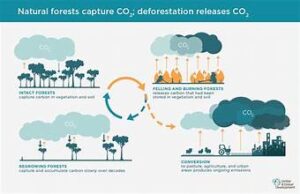
Forest conservation has become a critical issue on the global stage, driven by the urgent need to combat climate change, preserve biodiversity, and sustain vital ecosystems. As we approach 2024, it is essential to examine how global policies are shaping forest conservation efforts and identify effective strategies that can be implemented to ensure the protection of these invaluable resources.
1. The Importance of Forest Conservation
Forests play a crucial role in maintaining ecological balance. They absorb carbon dioxide, provide habitat for wildlife, regulate water cycles, and support livelihoods. However, deforestation and forest degradation continue to threaten these functions, contributing to climate change and loss of biodiversity.
2. Current Global Policies and Their Impact
2.1. The Paris Agreement
The Paris Agreement, adopted in 2015, is a landmark global treaty aimed at limiting global warming to below 2°C above pre-industrial levels. One of its key components is the emphasis on reducing emissions from deforestation and forest degradation. Countries are encouraged to develop Nationally Determined Contributions (NDCs) that include measures for forest conservation and sustainable land management.
Impact: The Paris Agreement has prompted many nations to integrate forest conservation into their climate action plans. This has led to increased funding for forest protection programs and the development of national strategies that align with global climate goals.
2.2. The Convention on Biological Diversity (CBD)
The CBD, established in 1992, focuses on conserving biodiversity, ensuring sustainable use of its components, and sharing benefits arising from genetic resources. The CBD’s Strategic Plan for Biodiversity 2011-2020 and the Aichi Biodiversity Targets emphasize the importance of protecting forest ecosystems and enhancing their resilience.
Impact: The CBD has influenced policies that promote the establishment of protected areas, restoration of degraded lands, and sustainable forest management practices. It has also fostered international cooperation and the sharing of best practices.
2.3. The UN Forest Instrument
The UN Forest Instrument, adopted in 2007, provides a framework for enhancing the sustainable management of forests. It includes principles for promoting good governance, ensuring stakeholder participation, and supporting the implementation of forest management strategies.
Impact: This instrument has guided national forest policies and actions, encouraging countries to adopt comprehensive approaches to forest management and conservation. It has also facilitated the integration of forest issues into broader environmental and development agendas.
3. Effective Strategies for 2024 and Beyond
3.1. Strengthening Legal Frameworks
Robust legal frameworks are essential for effective forest conservation. Governments should enact and enforce laws that protect forests from illegal logging, land conversion, and other forms of exploitation. This includes enhancing regulations on land tenure, forest management, and enforcement mechanisms.
Strategy: Review and update existing forest laws to address emerging challenges and ensure compliance with international agreements. Strengthen law enforcement through increased resources and training for authorities.
3.2. Promoting Sustainable Forest Management
Sustainable forest management (SFM) involves balancing environmental, social, and economic objectives to ensure that forests continue to provide benefits for future generations. This includes practices such as selective logging, agroforestry, and community-based forest management.
Strategy: Implement and promote SFM practices that align with global standards and certification systems, such as the Forest Stewardship Council (FSC) and Programme for the Endorsement of Forest Certification (PEFC). Support capacity-building initiatives for local communities and forest managers.
3.3. Enhancing International Cooperation
Forest conservation is a global challenge that requires international collaboration. Countries should work together to share knowledge, technologies, and resources. This includes participating in international initiatives, such as REDD+ (Reducing Emissions from Deforestation and Forest Degradation), which provides financial incentives for forest conservation in developing countries.
Strategy: Strengthen partnerships between governments, international organizations, NGOs, and the private sector. Support joint research initiatives and knowledge-sharing platforms to enhance global forest conservation efforts.
3.4. Leveraging Technology and Innovation
Technology can play a significant role in advancing forest conservation. Remote sensing, geographic information systems (GIS), and data analytics can provide valuable insights into forest health, monitor deforestation, and support decision-making.
Strategy: Invest in and promote the use of advanced technologies for forest monitoring and management. Support the development of innovative solutions that address specific conservation challenges, such as illegal logging and habitat fragmentation.
3.5. Engaging Local Communities
Local communities are often on the front lines of forest conservation. Their involvement is crucial for the success of conservation initiatives. Engaging communities in decision-making processes, providing incentives, and recognizing their rights can enhance the effectiveness of conservation efforts.
Strategy: Develop and implement community-based conservation programs that empower local people and promote sustainable livelihoods. Foster collaboration between communities, governments, and organizations to achieve shared conservation goals.
4. Conclusion
As we move into 2024 and beyond, the effectiveness of global policies in forest conservation will depend on the implementation of strategies that address both immediate and long-term challenges. By strengthening legal frameworks, promoting sustainable practices, enhancing international cooperation, leveraging technology, and engaging local communities, we can make significant progress in protecting our forests and ensuring their continued contributions to a healthy and sustainable planet.


